
Since the inaugural race in 1911, the Indianapolis 500 has become steeped in rich tradition, one of the most alluring aspects of "The Greatest Spectacle in Racing."
Here is the history of some of the most popular and enduring traditions of the Indianapolis 500.
500 Festival Parade
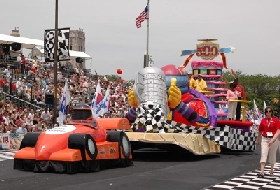
The 500 Festival Parade took place for the first time in 1957. It, and several other related activities, largely came about following a series of newspaper editorials by local columnists over a two- or three-year period, who had witnessed the several-day celebration in advance of the Kentucky Derby.
"Back Home Again in Indiana"
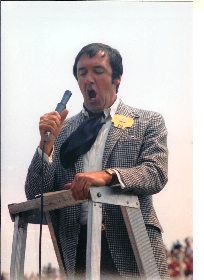
Although there are reports that "Indiana," as the song was originally titled when published in 1917, was played by a trackside brass band as Hoosier driver Howdy Wilcox ran out his final laps on the way to winning the 1919 "500," it was not until 1946 that it was sung on race morning. James Melton, of the New York Metropolitan Opera Company, was a collector of classic cars, and was at one time president of the Antique Automobile Club of America. He supplied several of the vehicles which participated in a race-morning lap of classic automobiles around the track in 1946, and approximately 45 minutes before the start of the race, he sang "Indiana" with the Purdue University band over the public address system. It was so well received that he was invited back the following year, and in 1948, it was decided to "move it up" to its current slot in the order of the day, just prior to the firing of the engines. Among Melton's better-known successors have been Mel Tormé, Vic Damone, Dinah Shore, Ed Ames, Peter Marshall, Dennis Morgan and Johnny Desmond, with popular Jim Nabors having missed only a handful of years since 1972.
Balloons Before the Start
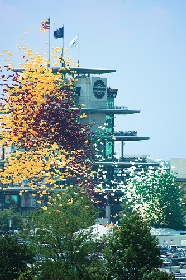
It is believed that 1947 was the first year for the release of multi-colored balloons on race morning and that it was Tony Hulman's wife, Mary Fendrich Hulman, who made the suggestion. By 1950, the release had been timed to coincide, as it does to this day, with the final notes of "Back Home Again In Indiana."
Borg Warner Trophy
- The Borg-Warner Trophy Specifications
- Trophy height without base: 52 inches
- Trophy height with base: 64.75 inches (or 5 feet, 4.75 inches)
- Trophy weight with base: Approximately 110 pounds
The Borg-Warner Trophy is one of the most coveted trophies in the world of sports. While it pays tribute to many of the most revered drivers in auto racing history year-round, during the Month of May it becomes the focal point for the drivers attempting to qualify for the Indianapolis 500 Mile Race, a reminder of the glory and tradition associated with winning the fabled event.
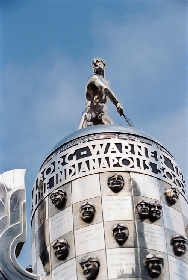
With victory at the Indianapolis 500 comes the honor of having one's face sculpted onto the 74-year-old trophy. Separate squares are affixed to its sterling-silver body, on which each winner's face, name and winning year are permanently etched. A silversmith is commissioned each year to create the new champion's portrait/sculpture in bas-relief for placement on the trophy.
In 1935, the Borg-Warner Automotive Company (now called BorgWarner) commissioned designer Robert J. Hill and Spaulding-Gorham, Inc., of Chicago, to create the trophy at a cost of $10,000.
Unveiled at a 1936 dinner hosted by then-Speedway owner Eddie Rickenbacker, the Borg-Warner Trophy was officially declared the annual prize for Indianapolis 500 victors. It was first presented that same year to champion Louis Meyer, who remarked, "Winning the Borg-Warner Trophy is like winning an Olympic medal."
The trophy was refurbished in 1992 and is valued at more than $1 million. Today, 96 faces grace the trophy's squares. The faces date back to Ray Harroun, winner of the first Indianapolis 500 in 1911, and include two sets of dual victors (one driver started the race and the other finished it) for 1924 and 1941. Four-time champions A.J. Foyt (1961, '64, '67, '77), Al Unser (1970, '71, '78, '87) and Rick Mears (1979, '84, '88, '91) are the only drivers to have their faces appear more than three times on the trophy. Mears is the only one of those three to have a new likeness rendered for each of his four victories. Tom Sneva (1983) is the only champion who appears on the trophy wearing his eyeglasses, by his request.
Besides displaying Indianapolis 500 champions, the trophy features a 24-karat gold head portrait of the late Speedway Owner and President Anton "Tony" Hulman Jr. in tribute to his rejuvenation of the track and the Indianapolis 500 after World War II. Hulman's image was added in 1987.
The last driver to have his likeness placed on the original trophy was Bobby Rahal in 1986, as all the squares had been filled. A new base was added in 1987, and it was filled to capacity following Gil de Ferran's victory in 2003. For 2004, BorgWarner commissioned a new base that will not be filled to capacity until 2034.
Since 1988, an 18-inch tall replica of the trophy, a "Baby Borg," has been crafted in sterling silver for presentation to the champion. A new tradition began with the 1997 winner as BorgWarner also presented the winning car owner with a "Baby Borg."
Each May, the Borg-Warner Trophy is featured at a number of Indianapolis 500 events, including the public drivers' meeting at the track, the 500 Festival Parade and the post-race Victory Celebration. Immediately after each race, the trophy is hoisted into Victory Circle with the winning car and driver for photographs.
Bump Day
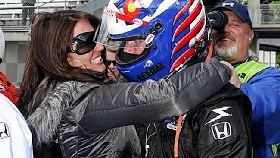
This is a fairly recent term for the final day of qualifications. It is theoretically the day on which, once 33 cars have posted qualifying speeds, but the allotted time for the day has not yet expired, the only way for a participant to be able to join the field is to post a speed fast enough to eliminate or "bump" the slowest car currently still in. The term for "bumped" prior to World War II was "crowded out." Technically, "bumping" could, and did, take place before the final day of qualifications. Under the new system introduced in 2005, "bumping" has taken on a slightly different meaning in that it can take place on every qualifying day.
Carb Day
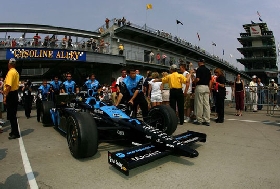
Known for many years as "Carburetion Day," and shortened only in fairly recent years simply to "Carb Day," it refers to the day on which cars qualified for the starting field are given the opportunity to practice in "Race Day trim," as opposed to the less economical setups required for out-and-out speed during time trials. A major portion of this used to involve adjustment to the carburetors, but even after the introduction of fuel injection in the late 1940s, the original term "carburetion runs" continued to be used. For the record, the stock-block Ford-powered Lotus cars of Jim Clark and Dan Gurney in 1963 were the last to actually use carburetors on Carburetion Day.
Gasoline Alley
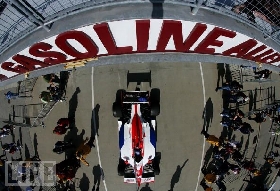
This is a nickname for the Garage Area in which the racing cars are housed at event time. It originally referred only to the one corner where the fuel depot was located, but over a period of years, it came to be applied to the entire complex. It seems to have first come into use sometime in the 1920s and possibly may have been the result of a newspaper strip cartoon of the same name which debuted in August 1919.
Gordon Pipers
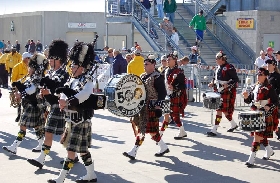
The Indianapolis 500 Gordon Pipers, better known as the Gordon Pipers, are a Scottish/Celtic bagpipe band that has been a fixture during Indianapolis 500 ceremonies on Opening Day, Qualification Days, the 500 Festival Parade and Race Day since 1963. Indianapolis Motor Speedway owner Tony Hulman heard a performance by the Pipers in June 1962. Impressed, he invited the band to perform at the 1963 Indianapolis 500 as the "Gasoline Alley Gordon Pipers." Each year, four bagpipers greet the winner of the Indianapolis 500 in Victory Lane for the traditional drink of milk and the Borg-Warner Trophy presentation. These four pipers signify the winning car coming to Victory Lane on four wheels.
Pace Car
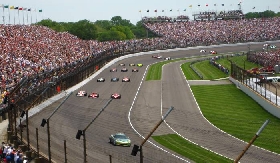
With a huge field of 40 cars having met the qualifying requirements for starting the inaugural Indianapolis 500 in 1911, track founder Carl Fisher reasoned that this might be too many for the typical standing starts then in vogue. He believed it would be safer instead to lead them around on one un-scored lap at approximately 40 or 45 mph and then release them to the flagman as he pulled into the pits. Now commonplace at motor racing events throughout the United States, this is believed to have been the very first mass rolling start for any automobile race anywhere in the world and quite possibly the first use of a pace car for a major event.
The Greatest Spectacle in Racing
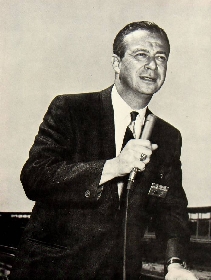
It was on Race Day 1955 when the world heard this famous phrase for the first time. While made famous by Sid Collins, chief announcer for the Indianapolis Motor Speedway Radio Network broadcast of the "500," it was actually a young lady who coined it. Dating back into the mid-1920s, radio broadcasts of the "500" typically consisted of a few minutes of coverage of the start and the finish, with brief updates in between, aired every 15 or 30 minutes. When the track created its own network in 1952, this same format was continued. In 1953, however, history was made when the race was covered in its entirety, with no breaks at all except for commercials. When representatives of the skyrocketing number of subscribing stations were asked for comments and feedback, the most common request was that their engineers could be alerted to an impending commercial break by use of a standard "out cue." The request was turned over to the sales staff of Indianapolis radio station WIBC, the network's "flagship" station, and it was a female copywriter in her early 20s named Alice Greene who suggested the enduring classic, "Stay tuned to the Greatest Spectacle in Racing."
Winner's Drink of Milk
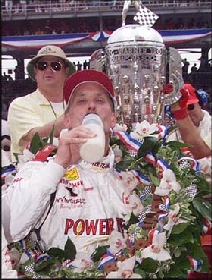
Three-time "500" winner Louis Meyer regularly drank buttermilk on a hot day, as his mother had told him it would refresh him, and he consumed some in Victory Lane as a matter of course after earning his third "500" victory in 1936. A dairy industry executive happened to see a photograph of this in the following day's newspaper and, believing it to be regular milk, vowed to make sure this would be repeated in the coming years. Milk was part of the Victory Lane ceremony between 1937 and 1941 and then again in 1946, the first year after World War II, but disappeared between 1947 and 1955. The tradition was revived in 1956 and continues to this day.
Yellow Shirts
From the time the Indianapolis Motor Speedway opened in 1909 until immediately after World War II, all events at the track were policed by the Indiana National Guard. Shortly after Tony Hulman purchased the track in November 1945, one of his right-hand men, Joseph Quinn of the Clabber Girl Baking Powder Company, set up a Board of Safety which sought input from all of the major law enforcement agencies. By 1948, the track's own Safety Patrol had been established, featuring dark-blue uniforms and pith helmets, those of department heads painted gold, and the rank and file, silver. The long-sleeved shirts, made of wool, were extremely uncomfortable to wear, both on a hot day and when soaked with rain. In the early 1970s, some of the senior staff members switched on weekends to considerably more comfortable short-sleeved yellow shirts, while golden plastic "bump" or "batting" helmets replaced the pith helmets. By 1975, all of the blue uniforms had disappeared completely; baseball caps had replaced the bump helmets and the term "yellow shirt" had come into vogue.
Pagoda
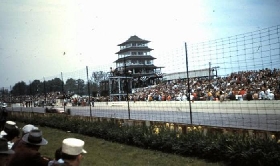
The Pagoda, begun in 1998 and completed in 2000, replaced the glass-and-steel Master Control Tower, which was built during the winter of 1956-57. Prior to that time, a Japanese-style pagoda had occupied the spot. In fact, there were two of them, the first being built in time for the 1913 "500" and serving through 1925. It housed the press, timing and scoring, prominent officials and VIP guests and, toward the end of its run, a radio broadcast booth. Because it stood fairly close to the edge of the track, it was decided, for safety reasons, to replace it for 1926 with a newer version located a few yards farther back. The current building, which has 10 stories and rises to the height of a 13-story building, has a subtle suggestion of the old pagodas designed into it for reasons of nostalgia
The Yard of Bricks
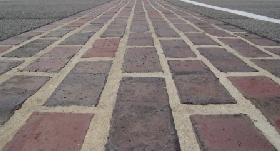
The Yard of Bricks is another nostalgic link with the past. After the track's original surface of crushed rock and tar was abandoned after only a few days of use in August 1909, it was replaced during that fall by 3.2 million street-paving bricks, trucked in by rail from the western part of the state. Approximately 90 percent were Culver Blocks, manufactured by the Wabash Valley Clay Company of Veedersburg (near the Illinois border), the remainder being supplied by other firms in the same general area. The bricks were laid on their side in a bed of sand, staggered in rows and separated by about 3/8th of an inch on either side so that mortar could be poured between them for strengthening. In the spring of 1936, patches of asphalt were applied to the rougher portions of the turns. Over the next couple of years, more and more asphalt was applied, so that by the time of the 1939 race, only about 650 yards of the main straight were still of bricks. This portion survived for another 22 years until October 1961, when it too was covered over, leaving exposed only 3 feet for the entire width of the track at the start/finish line. The entire 2.5 miles has been resurfaced several times since then, with a fresh batch of the original bricks being inlaid at the start/finish line once the new surface has had time to harden.
Winner's Wreath
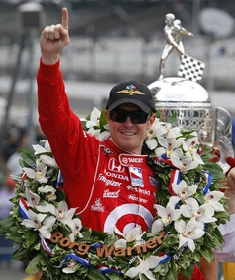
Long used in Grand Prix racing, the winner's wreath at Indianapolis appears to have debuted in 1960, when a wreath featuring several exotic-looking, dark-yellow and brown flowers was placed on the shoulders of Jim Rathmann. A garland of white and red carnations of the type normally associated with horse racing was placed around the shoulders of A. J. Foyt in 1961, and in 1962, Rodger Ward wore a wreath not too dissimilar from those seen today. Underwritten by Borg-Warner Corporation, the wreaths were the creation of William J. "Bill" Cronin, a longtime Indianapolis florist, who was at one time a floral consultant for the parades of the Rose Bowl, Cotton Bowl and the 500 Festival. He died in 1989. For most of the last 30 years, the wreath has featured 33 ivory-colored Cymbidium orchids with burgundy tips, plus 33 miniature checkered flags, intertwined with red, white and blue ribbons.
*Information about traditions of the Indianapolis Motor Speedway were obtained from the official website of the Indianapolis 500 Mile Race www.indianapolismotorspeedway.com











